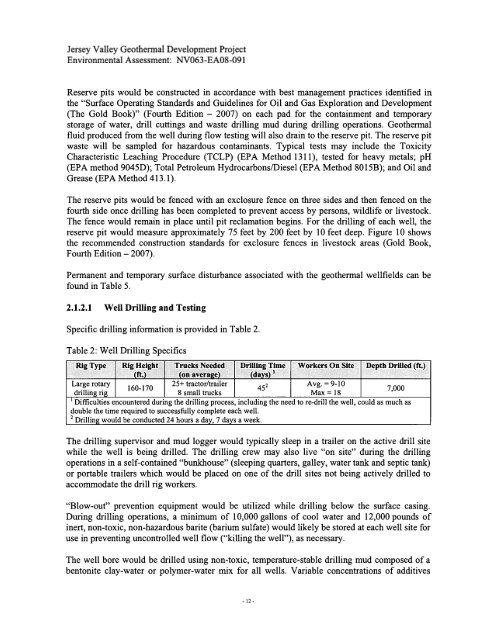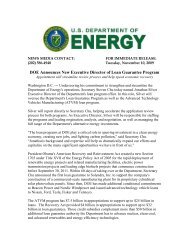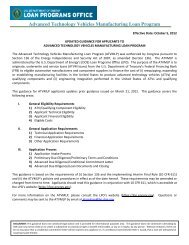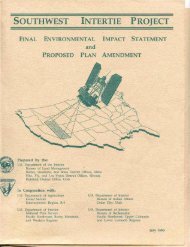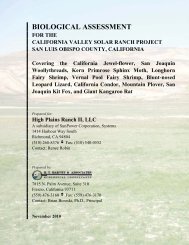Bureau of Land Management's Decision Record and Environmental
Bureau of Land Management's Decision Record and Environmental
Bureau of Land Management's Decision Record and Environmental
Create successful ePaper yourself
Turn your PDF publications into a flip-book with our unique Google optimized e-Paper software.
Jersey Valley Geothermal Development Project<br />
<strong>Environmental</strong> Assessment: NV063-EAO8-091<br />
Reserve pits would be constructed in accordance with best management practices identified in<br />
the “Surface Operating St<strong>and</strong>ards <strong>and</strong> Guidelines for Oil <strong>and</strong> Gas Exploration <strong>and</strong> Development<br />
(The Gold Book)” (Fourth Edition — 2007) on each pad for the containment <strong>and</strong> temporary<br />
storage <strong>of</strong> water, drill cuttings <strong>and</strong> waste drilling mud during drilling operations. Geothermal<br />
fluid produced from the well during flow testing will also drain to the reserve pit. The reserve pit<br />
waste will be sampled for hazardous contaminants. Typical tests may include the Toxicity<br />
Characteristic Leaching Procedure (TCLP) (EPA Method 1311), tested for heavy metals; pH<br />
(EPA method 9045D); Total Petroleum Hydrocarbons/Diesel (EPA Method 8015B); <strong>and</strong> Oil <strong>and</strong><br />
Grease (EPA Method 413.1).<br />
The reserve pits would be fenced with an exclosure fence on three sides <strong>and</strong> then fenced on the<br />
fourth side once drilling has been completed to prevent access by persons, wildlife or livestock.<br />
The fence would remain in place until pit reclamation begins. For the drilling <strong>of</strong> each well, the<br />
reserve pit would measure approximately 75 feet by 200 feet by 10 feet deep. Figure 10 shows<br />
the recommended construction st<strong>and</strong>ards for exclosure fences in livestock areas (Gold Book,<br />
Fourth Edition — 2007).<br />
Permanent <strong>and</strong> temporary surface disturbance associated with the geothermal weilfields can be<br />
found in Table 5.<br />
2.1.2.1 Well Drilling <strong>and</strong> Testing<br />
Specific drilling information is provided in Table 2.<br />
Table 2: Well Drilling Specifics<br />
Rig Type Rig Height Trucks Needed I Drilling Time orkers On Site I Depth<br />
.. (ft.) (on average) I (days)<br />
Large rotary I 25+<br />
160-170 I<br />
tractor/trailer 452 Avg. 9-10<br />
I drilling rig 8 small trucks I Max = 18<br />
I i Difficulties encountered during the drilling process, including the need to re-drill the well, could as much as<br />
I double the time required to successfully complete each well.<br />
2 Drilling would be conducted 24 hours a day, 7 days a week.<br />
The drilling supervisor <strong>and</strong> mud logger would typically sleep in a trailer on the active drill site<br />
while the well is being drilled. The drilling crew may also live “on site” during the drilling<br />
operations in a self-contained “bunkhouse” (sleeping quarters, galley, water tank <strong>and</strong> septic tank)<br />
or portable trailers which would be placed on one <strong>of</strong> the drill sites not being actively drilled to<br />
accommodate the drill rig workers.<br />
“Blow-out” prevention equipment would be utilized while drilling below the surface casing.<br />
During drilling operations, a minimum <strong>of</strong> 10,000 gallons <strong>of</strong> cool water <strong>and</strong> 12,000 pounds <strong>of</strong><br />
inert, non-toxic, non-hazardous barite (barium sulfate) would likely be stored at each well site for<br />
use in preventing uncontrolled well flow (“killing the well”), as necessary.<br />
The well bore would be drilled using non-toxic, temperature-stable drilling mud composed <strong>of</strong> a<br />
bentonite clay-water or polymer-water mix for all wells. Variable concentrations <strong>of</strong> additives<br />
-12-


